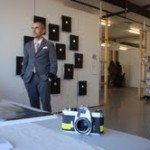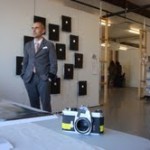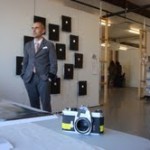- photo by Gabriella Radujko
Whereas Man Ray and László Moholy-Nagy famously eliminated the camera altogether to make photograms by capturing light directly, Brad Farwell retains the camera, but not the lens for his ongoing series Die Transfer Process. The artist was one of twenty artists-in-residence showing at the Lower Manhattan Cultural Council’s Final Open Studios in Building 110 on Governors Island on December 9, 2011. The wall installation features about a dozen unique, 35mm transparencies shown with Polaroid slide mounts, atop custom light boxes staggered on a white wall covering approximately 6’ x 8’. White extension cords were in plain sight. Farwell gives viewers the physical object, but the images are not much more than the color field. Irresolvable in their lack of focus and reminiscent of the painterly effects associated with Helen Frankenthaler, the artist offers, “what is being photographed is not the subject of photography”.
He delivers what one studio visitor described as a “luminous experience” by blending formalistic techniques which distort the subject “beyond recognition” and are indeterminable in advance with elements of a category of occult photography known as supernatural; the Oxford Companion to the Photograph describes supernatural images as those which “more or less show what an observer present during the exposure could have seen” and more important, do not show ‘the invisible’.
Subsequently, two of the images, Reading the email telling me Oscar had died and The sun setting on Riley’s birthday, with Hannah screaming in the background capture the emotionally charged moments selected, but they are not representational. The viewer must create the narrative, and in some ways, according to Farwell, the photograph. The image is beyond recognition even though the camera, minus lens, produced an “aide-mémoire”.
The installation ranks high in mischievousness, hiding what was once in plain sight and then coaxing the viewer to complete the final image. With no two final results alike, Die Transfer Process will have succeeded in engaging audiences in a creative process using a space no larger than the one found on their cell phones.




 RSS
RSS
